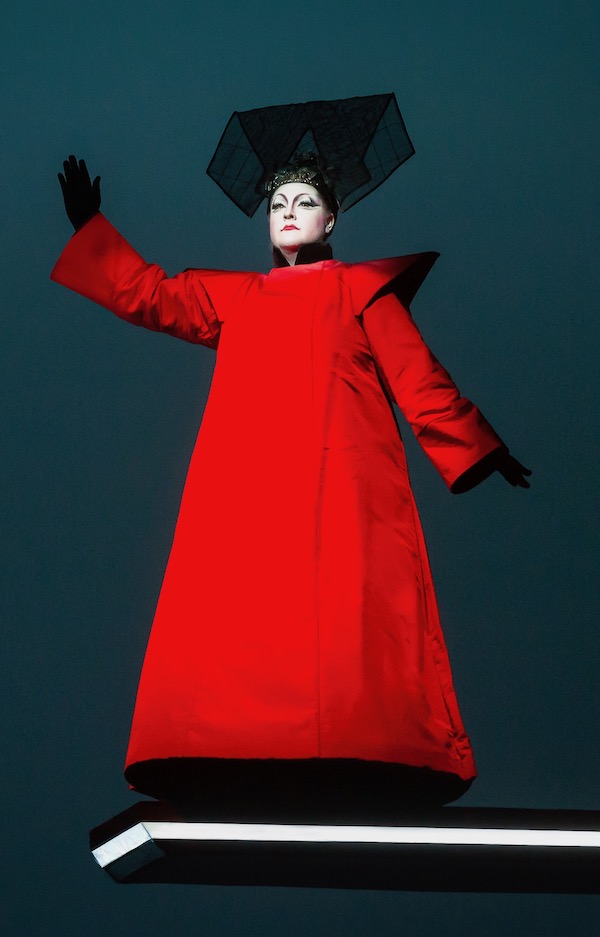Tamara Wilson brings resplendent vocalism to HGO’s static “Turandot”

For its first performances of Puccini’s Turandot in nearly 20 years, Houston Grand Opera went for theatrical cachet–presenting the U.S. premiere of a production by Robert Wilson, internationally celebrated for his opera stagings’ non-realistic design and movement.
One might have guessed that Wilson’s vision of Turandot would be the newsiest element of the opening night at Wortham Theater Center. But no. What really galvanized Puccini’s fairy-tale drama Friday was Tamara Wilson’s commanding yet multifaceted portrayal of the titular ice princess.
The role is notorious for demanding a soprano who boasts the power, stamina and clarion high notes to put across Turandot’s man-hating imperiousness, all the while standing up to a massive orchestra’s competition. Wilson summoned all that and more—bringing back memories of her full-throated Chrysothemis in HGO’s 2018 Elektra.
During Turandot’s entrance aria, “In questa reggia”—Wilson’s voice took a couple minutes to come into focus. By the time she reached the soaring climactic phrases, her voice’s vibrancy and luster shone through.
As Wilson’s Turandot confronted her latest suitor, Calaf, with the three riddles he must answer to determine his fate, Wilson’s singing grew all the more brilliant, and the music’s voltage surged. When Calaf, to the princess’s horror, successfully solved the riddles, the soprano’s blazing tone lent visceral force to Turandot’s revulsion without ever turning strident.
And in the final scene, with Calaf’s kiss finally melting Turandot’s resistance, Wilson’s voice trumpeted with as much gleam as the actual trumpets in the orchestra—and more security on opening night.
But Wilson’s Turandot displayed more than ferocity. When the princess invoked her slain ancestor Lou-Ling during “In questa reggia,” Wilson’s voice softened at the words “ava dolce e serena”—“ancestor sweet and serene,” conveying Turandot’s affection for and bond with the tragic figure.
Even amid the vocal theatrics of the Riddle Scene, Wilson at times drew back her voice to a near-whisper. And in Act 3, when Turandot asked the slave girl Liu—who sacrifices herself for Calaf—how she could face death so courageously, Wilson’s softness hinted that something was already changing within the princess’s soul.
Kristian Benedikt as Calaf didn’t offer that kind of dramatic subtlety. His tenor was sturdy and stentorian: as Calaf confronted Turandot in the final scene to declare his victory, Benedikt hurled out his words—“Princess of death! Princess of ice!” with a raw force that showed Calaf had no fear.
But Benedikt delivered practically everything that way. He sang Calaf’s “Nessun dorma,” the opera’s best-known number, more like a declaration of gritty resolve than a lyrical outpouring born of passion. Benedikt fitfully reined in the volume a bit—when he saluted Liu as “my sweet girl,” for instance. But the change was too slight and too fleeting to make this Calaf more than a cardboard figure.
As Liu, the story’s most sympathetic character—and the one Puccini gave the score’s most glowing music to—soprano Nicole Heaston needed time to settle in. During Liu’s first scene, centered on her aria “Signore, ascolta,” Heaston sang with fervor, but her voice sounded a little pressed. Only in Liu’s final avowal of devotion to Calaf—“Tu che di gel sei cinto”—did Heaston bring the requisite Puccini touches of sweetness and warmth, as in her Mimi in HGO’s 2018 La Boheme.
As the three comic courtiers, baritone Takaoki Onishi and tenors Andrew Stenson and Carlos Enrique Santelli—respectively Ping, Pang and Pong—sang with vitality and wryness galore, but also conveyed wistfulness when the ministers recollect the idyllic places they would rather be than Beijing. Bass Peixin Chen’s deep, majestic tones served notice that the weak and aged Timur, Calaf’s father, is a former king.
Wilson’s production was eye-catching, but not through the traditional brand of Turandot spectacle. Instead, it emphasized starkness and simplicity.
Co-designed by Wilson and Stephanie Engel, the set eschewed stationary pieces. It consisted mainly of sliding black panels and, at the beginning of Act 3, a tangle that suggested vines engulfing the stage. Video projections by Tomasz Jeziorski added an occasional scenic ingredient—such as the long-awaited appearance of the moon in Act 1.
Wilson’s bold visual strokes came mainly from the likes of the crowd silhouetted against the backdrop, stage tableaux laid out spaciously and, after Turandot herself appeared, splashes of the color red catching fire amid the prevailing darkness.
Turandot’s capacious and angular red robe, designed by Jacques Reynaud, symbolized not only her bloodthirstiness but, through its rigidity, her frozen heart—a theatrical example of the clothes making the woman. As the story unfolded, the stage backdrop sometimes glowed red as well. In the final moments, a single vertical shaft of white pierced the redness to symbolize the dawn.
In keeping with Wilson’s static style, the characters’ movements—co-directed by Nicola Panzer—emphasized stylized gestures, often held for long periods, and stillness. Some singers brought this off better than others—Heaston tended to make a given stance more evocative than, say, Benedikt.
When Wilson’s Turandot glided into the midst of this—her legs and feet invisible—her costume restricted her largely to fierce gestures of her hands. But Wilson’s singing filled in everything else.
Led by conductor Eun Sun Kim, the HGO Orchestra complemented the three courtiers’ airiness, bringing Turandot a dash of grace that often is neglected. Kim and the orchestra also lent transparency to the moments of mystery and delicacy, propelled the vitality and ruggedness of the crowd scenes, and lent glow to the score’s relatively few—for Puccini—bursts of lyricism.
The HGO Chorus sang with cohesion and decisiveness, but didn’t register with the sheer heft that would have captured the ferocity of the bloodthirsty crowd. Wilson’s staging generally clumped the group at the rear of the stage, and always on one level—so that many of the choristers sang directly into the backs of their colleagues’ heads. That didn’t help matters.
Turandot runs through May 8 at Wortham Theater Center. houstongrandopera.org


